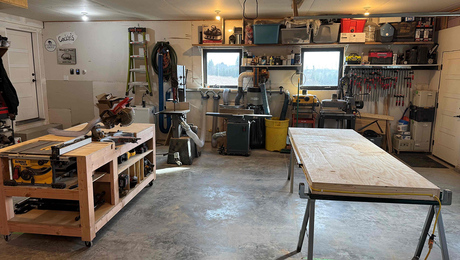I want to thank those who responded to my last question (cement board under hardwood). Now I have created a new problem. I installed 8″ x 8″ limestone tile with chip-beveled edges (only way I can explain it) on my bathroom floor. I left 1/8″ grout lines. Now I worry how to get the grout in between the tiles without it getting into the grooves. I have sealed the tiles well (and they look great) but I don’t want to get grout all over them. How does those pastry bags work? Appreciate any advice.
Discussion Forum
Discussion Forum
Up Next
Video Shorts
Featured Story

Listeners write in about running a profitable contracting business and ask questions about patching drywall, adding air barriers, and fixing a patio poured against the house.
Featured Video
SawStop's Portable Tablesaw is Bigger and Better Than BeforeHighlights
"I have learned so much thanks to the searchable articles on the FHB website. I can confidently say that I expect to be a life-long subscriber." - M.K.
Fine Homebuilding Magazine
- Home Group
- Antique Trader
- Arts & Crafts Homes
- Bank Note Reporter
- Cabin Life
- Cuisine at Home
- Fine Gardening
- Fine Woodworking
- Green Building Advisor
- Garden Gate
- Horticulture
- Keep Craft Alive
- Log Home Living
- Military Trader/Vehicles
- Numismatic News
- Numismaster
- Old Cars Weekly
- Old House Journal
- Period Homes
- Popular Woodworking
- Script
- ShopNotes
- Sports Collectors Digest
- Threads
- Timber Home Living
- Traditional Building
- Woodsmith
- World Coin News
- Writer's Digest


















Replies
Cake decorator bags are nice for small areas, but I wouldn't expect it to deliver grout perfectly into 1/8" gaps. For a recent tile project, I made my own mini cake decorator, I think the gaps were a bit more than 1/8". Anyway, what's important is that you seal the tile before you grout, a couple times.
You can give the cake decorator a try, but it's quite a bit slower. you'll need to watch the consistency of your grout so it doesn't set up in the bag, too.
whether you cake decorate or float the grout, have a sponge and lots of water nearby, and start cleaning when you're done grouting. clean off the tiles closer and closer to the grout as it sets up. when the grout is firm enough to not get damaged or muddy, I clean the tiles with a rag dipped in white vinegar, then rinse with water and a sponge.
zak
Wow - you're good. Did you use non-sanded grout? I don't mind if it is slow as this is a small 1/2 bath and I love the look of the natural limestone. I just don't want to screw it up like I do many of my projects.
Well, for my bathroom (~3/16" grout lines were the smallest) I used sanded grout. For a counte I just did, I used epoxy grout (no sand), which is great, though cleanup is more difficult and more important. However, the grout is very strong and totally waterproof.
zak
For future reference, you might want to consider a slightly larger grout line for the style and size you are talking about here. Only true squared tiles get such a small joint IMO. But there are no such "rules" set in stone.
That said, I wouldn't be terribly concerned with containing the grout solely within the joint. In fact, it might look downright odd. The transition between this type of tile and grout should be gradual....not a sharp contrast.
J. D. Reynolds
Home Improvements
Good advice from Zak.
A problem with the pastry bags from my experience is that in order to get the grout to squeeze out you need to add too much water to the grout. Wetter grout is messier to clean up too. The extra water will make the grout shrink and crack. I like to mix the grout stiff and almost crumbles. Grout the usual way with a float and lots of pressure. 1/8" grout lines will look wider with the chipped beveled edges.
Limestone is one of the easier stones to grout because it is not usually cleft like slate or quartzite. It will still be twice as much work to clean up compared to ceramic tile. I would only mix enough to do about 30 SQ FT at a time so the grout setting up doesn't get away from you.